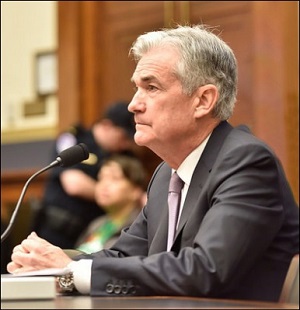By Pam Martens and Russ Martens: September 18, 2019 ~

Federal Reserve Chairman Jerome Powell Gives Testimony Before the House Financial Services Committee on February 27, 2018
Yesterday felt a little like that scene from the 1946 movie “It’s a Wonderful Life” starring Jimmy Stewart. There’s a run on Stewart’s bank because his absent-minded Uncle Billy loses the cash he was sent off to deposit on behalf of the bank. The bank examiners discover there’s money missing and rumors spread.
The rumors that spread yesterday were not that money was missing at a Wall Street bank but that liquidity was missing. It had dried up to the point that the major Wall Street banks could not, or would not, handle the demand for loans called overnight repurchase agreements (repos) that were coming their way. (Repos are a short-term form of borrowing where corporations, banks, brokerage firms and hedge funds secure loans by providing safe forms of collateral such as Treasury notes.)
The oversized demand for the repos and the lack of available funds drove the overnight repo rate to an unprecedented high of 10 percent at one point. Typically, the overnight repo rate trades in line with the Federal Funds rate, which is currently targeted at 2 to 2.25 percent by the Fed.
The Federal Reserve Bank of New York (always there to rescue Wall Street from its hubris; see “Related Articles” below) had to jump in and infuse $53 billion into the repo market. It has promised to make another $75 billion available this morning.
Here’s what should concern every engaged American: As of June 30 of this year, the four largest banks on Wall Street (which are allowed to own Federally insured commercial banks as well as stock, bond and derivative gambling casinos known as investment banks) held more than $5.45 trillion in deposits. The breakdown is as follows: JPMorgan Chase holds $1.6 trillion; Bank of America has $1.44 trillion; Wells Fargo has $1.35 trillion; and Citibank is home to just over $1 trillion.
A number of excuses have been offered by the business press to explain why the New York Fed had to ride to the rescue yesterday but the very simple question is this: how can four banks with $5.45 trillion in deposits not be able to cough up $53 billion in overnight loans.
The excuses go like this: corporations had to pay their corporate taxes and drew down large amounts from the banks. But corporations paying their taxes is not some new problem that just fell out of the sky. These are very old banks that should certainly know how to anticipate a drawdown for corporate taxes. The next excuse is that liquidity at the banks was drained as a result of paying for Treasury securities purchased in last week’s Treasury auction. The major Wall Street banks are all “primary dealers,” which are contractually bound to make purchases in the regular Treasury auctions. But again, this has been going on for decades and sophisticated banks should be able to figure out how to make bids in the Treasury auctions while still leaving themselves with adequate liquidity for their customers.
One of the more reasonable theories is that the backup in interest rates that caused bond prices to tank last week drove an investor stampede out of bonds, forcing the Wall Street banks to buy back large amounts of unwanted bonds from customers, thus further draining their liquidity.
Then there is the problem that these same four banks, together with Goldman Sachs and Morgan Stanley, own 90 percent of the $272.5 trillion in derivatives at U.S. bank holding companies. (See Table 2 in the Appendix of the most recent report from the Office of the Comptroller of the Currency.)
Given the fact that the last time the Fed was intervening in this fashion in the overnight lending market there was a major crisis on Wall Street with century-old iconic names vying for which one would go belly up first, one would have expected to see a serious percentage decline in the share prices of these banks during stock market trading hours yesterday. That didn’t happen. The worst of the bunch was Morgan Stanley, which closed down 1.21 percent.
Unfortunately for taxpayers, who will inevitably be on the hook again if things so south on Wall Street, everything is always fine on Wall Street – until it isn’t. And when Wall Street really begins to unravel, it does it at lightning speed.
This Fed intervention means that all eyes will be on the Federal Reserve’s announcement at 2 p.m. today as to whether it is cutting its Fed Funds target rate further – which President Donald Trump has been demanding in Tweets for months. The Chairman of the Federal Reserve, Jerome (Jay) Powell is slated to hold a press conference at 2:30 p.m. today, where he is certain to be grilled over what’s going on with repo rates.
Related Articles:
Bernie, It’s Time to Audit the New York Fed
Is the New York Fed Too Deeply Conflicted to Regulate Wall Street?
Why Americans Don’t Trust the Fed: It’s Too Damn Secretive
U.S. Senate Tries Public Shaming of New York Fed President Dudley
New York Fed’s Answer to Cartels Rigging Markets – Form Another Cartel

